Budget Micro-ATX P55 Faceoff: Gigabyte GA-P55M-UD2 and ASRock P55M Pro
by Gary Key on October 5, 2009 12:30 PM EST- Posted in
- Motherboards
Software
GIGABYTE provides several software applications with the GA-P55M-UD2, EasyTune6, D.E.S 2, and Smart 6 being the three main ones.
EasyTune6

GIGABYTE's EasyTune6 application provides monitoring, system information, and overclocking capabilities. This is one of the better applications provided by the various motherboard suppliers for tuning a system within Windows. We would still like to see additional voltage readings and the ability to save the settings to the BIOS - or at least a BIOS profile. The version shipped on the driver CD did not allow Bclk changes, but the updated version on the website works correctly.
We still prefer tuning within the BIOS. Other than that, this application is useful for extracting a decent amount of performance improvement out of the system after booting Windows. One benefit of such an approach is that you can reduce performance - along with power requirements and the stress on a system - without rebooting.
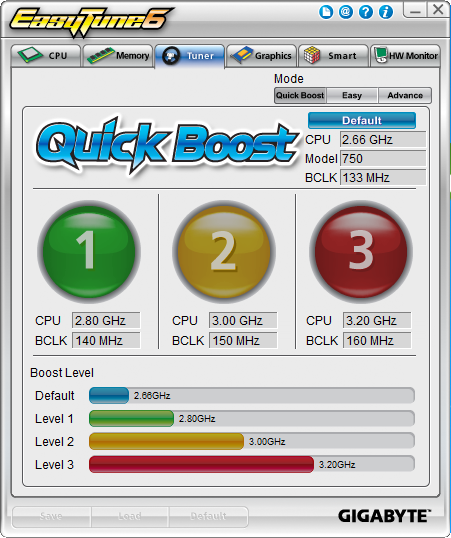
Quick Boost mode is a simple way for novice users to quickly overclock their systems without entering the BIOS. Once you click on one of the three boost levels, the utility will automatically optimize system settings according to your specific hardware combination. A reboot is required since this not an on-the-fly routine. The program is based on algorithms of hardware that has been pre-tested by GIGABYTE engineers unlike the MSI and ASUS offerings that evaluate your actual hardware configuration.
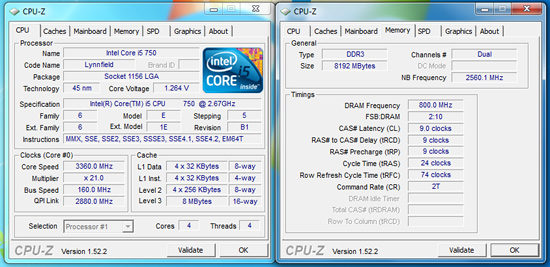
We tried around fifteen different hardware combinations and all worked correctly. Of course, it should work as the single core turbo mode on the i5/750 hits 3.2GHz without a problem, even when undervolting. Of course, with the Level 3 overclock, all four cores will be operating at 3.2GHz which comes in handy with video/audio encoding or 3D rendering programs. Although our memory kit was capable of C7 settings at DDR3-1600, at least this application set the board to DDR3-1600 speeds. Otherwise, the aggressive turbo modes on the Lynnfield processors have just about made this particular feature useless.
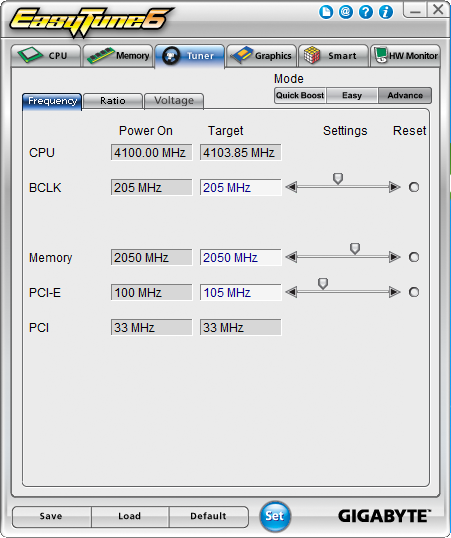
For those who appreciate and want a manual approach to overclocking, the Tuner tab has two different options. Easy mode allows control over Bclk, but it is Advance mode that opens several on-the-fly tweaking options that actually work. You can adjust Bclk, memory speed, PCI-E frequency, and numerous voltage options.
We have to say that using EasyTune6 was an almost painless experience although we prefer BIOS tuning on this platform. During the more extreme overclocking tests, this was the first application we loaded after getting the OS installation up and running. ET6 can be a huge help in tweaking those final settings to find a motherboard's overclocking limits.
DES 2
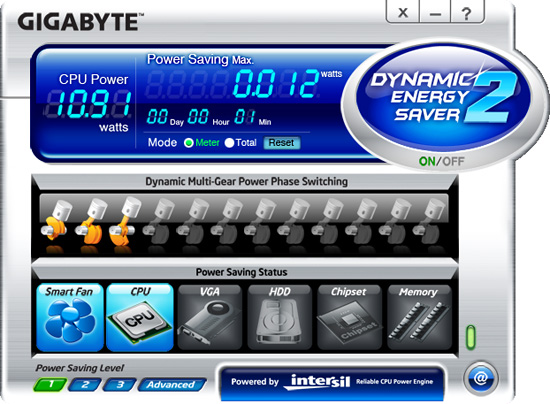
One of the most highly touted features from GIGABYTE is their Dynamic Energy Saver (DES 2) advanced power management solution. GIGABYTE provides a Windows-based software application to control DES 2. After installing the software (we highly recommend downloading the latest version) and a quick reboot, the application is ready for use. The control panel is powered down by default and it is up to the user to turn it on with a simple click of the DES button.
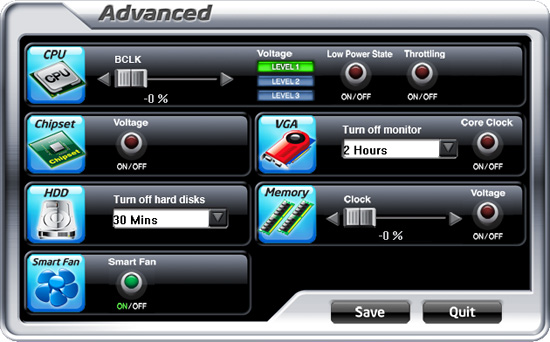
The DES software is simple to use and easy to understand. GIGABYTE provides a power savings meter in the top portion providing us with power savings information that can be reset at startup; otherwise it will track the power savings since the installation of the product. Real-time CPU power usage is available along with a graphic representation of the phases in use. You can also enable CPU throttling to save additional power during operation. The advanced tab lets you set power saving options for other peripherals, although we did not notice any additional power savings compared to Windows 7 default setup.
GIGABYTE also includes an onboard LED system that indicates the number of phases in use. These LEDs can be turned on and off from the control panel. The user can utilize DES while the system is overclocked although we typically did not measure any power savings in CPU bound applications, but games tended to respond well with a 3%~9% power savings.
Smart 6

Gigabyte also includes their new Smart6 software package that consists of Smart Quickboot, Smart Quickboost, Smart Recovery, Smart DualBIOS, Smart Recorder, and Smart Timelock. Smart Quickboot is a simple way to quickly set S3 sleep state in the BIOS and enable Hibernation in Windows. Smart Quickboost is the auto overclock application in ET6.
Smart Recovery is a method to quickly backup files or directories but not complete OS images. The unusual feature here is that even reformatting the drive will retain this hidden partition and data. We tried, it works. Smart DualBIOS is a personal recorder for saving important dates or password in the BIOS. Even if you lose this information in the OS, it is still retained. The downside is that reflashing the BIOS wipes the data clean. SmartRecorder is basically a time logging program to track access times and monitor file changes. Smart Timelock is a software application that can lockout a PC user for a certain period of time, but the time period considers a day to be only eight hours.
















55 Comments
View All Comments
yacoub - Tuesday, October 6, 2009 - link
785G is just onboard graphics halfbreed between 780 and 790 or whatever. until AMD releases a new line of high-end boards worth reviewing, why bother?haplo602 - Wednesday, October 7, 2009 - link
P55 is just half a chipset, i5 took over some of the functionality anyway ... why bother ?tommy101 - Wednesday, September 8, 2010 - link
beastyhacks79.smfnew.com the best psp hacking sitebollux78 - Tuesday, October 6, 2009 - link
Why do we need PCI anymore? I´ll tel you why: The PCI bus is more than enough for a hell bunch of applications, that´s it. If you have a damn good sound card or video capture, or whatever the card you have, and it´s PCI, you´d love to have the slot in there, because you don need to ditch that card and bet a "fantastic" PCIE x1 new card.C´mon people, let´s use the computer for the right purpose, not just to give money to the manufacturers buying new parts that you don´t
necessarily need.
I know, I´m being inflexible and oldschool, but, please, evolution is one thing, marketing is a completely different animal.
strikeback03 - Tuesday, October 6, 2009 - link
IMO it is more a board real estate problem than a case of buying the latest and greatest. On these P55 uATX boards you have 4 slots, one of which has to be devoted to graphics unless it is a headless server. If you use a dual slot graphics card (which a substantial portion of the readers on this site) you lose a second slot, and ideally you would have an open slot beneath that to ease airflow. So that leaves you with one or in a pinch two slots, therefore what interface they are is quite important. PCIe has been out on boards for what, 5-6 years now? I'd say its time to stop selling PCI cards and leave the PCI slots only on full ATX boards (plus maybe a few HTPC-oriented uATX boards) and let the interface finally die off.Though I'd say IDE has even less of a place now, SATA hard drives have been the norm for years and even optical drives for a few years. Time to upgrade if you are still carting one of those around.
sonicdeth - Monday, October 5, 2009 - link
Thanks Gary for the detailed review. Can't wait for the p55 roundup, and I'm also very interested now in your audo codec review.mindless1 - Monday, October 5, 2009 - link
... but I don't see the sense in SLI on mATX. Using the typical long video cards means you can't have a shorter depth case, just shorter height and since when is the area above your computer case a vital piece of real-estate?With 2, 8 or 16X slots onboard it only makes sense to me to go full ATX, is someone with the system budget to build a powerhouse gaming machine really poor enough, indescriminating enough, or young enough (to not have desirable cards from past systems) they don't want to add some other cards?
I hate to say it but this is getting to be a madness, the idea that we need to focus centrally on gaming ability of a board. Most people are not hard core gamers, but factually speaking, most hard core gamers don't do SLI either. Granted you can use a 16x slot for cards with fewer lanes, that seems the only saving grace for the two boards.
It's getting to the point I want a cTX case design where the drive racks are not in front of the mainboard and PSU, they are above them, so the case is even taller than std. ATX but not as deep.
Might tip over a little easier but earthquakes are rare here and plenty of other household items are more tip-happy than that would be.
strikeback03 - Monday, October 5, 2009 - link
There are cases made to hold a uATX board lying on the bottom, making it kinda a wider Shuttle. I'm personally looking for full ATX as well though, as the height doesn't matter too much to me (pretty sure anything short of a ABS Canyon or some of the bizarre decorative cases would fit under my desk) and don't want to limit my slot selection.Sunburn74 - Monday, October 5, 2009 - link
Hey Anand,Gigabyte boards have on issue that drives me nuts. As soon as you start overclocking them, you lose the ability to S3 sleep. When you do your maximal overclocks for various board reviews, would you mind testing if S3 sleep was maintained at those maximal overclocks?
Gary Key - Monday, October 5, 2009 - link
This board resumes from S3 (USB keyboard) at up to 215 Bclk (mentioned in the thoughts section, make that more visible next time) with our setup and that includes an external hard drive on the Firewire port which is properly instructed to shut down and restart.